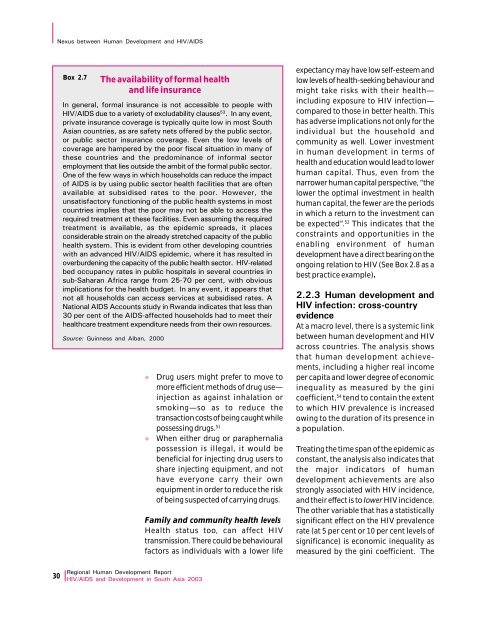Download Report - UNDP Asia-Pacific Regional Centre - United ...
Download Report - UNDP Asia-Pacific Regional Centre - United ...
Download Report - UNDP Asia-Pacific Regional Centre - United ...
You also want an ePaper? Increase the reach of your titles
YUMPU automatically turns print PDFs into web optimized ePapers that Google loves.
Nexus between Human Development and HIV/AIDSBox 2.7The availability of formal healthand life insuranceIn general, formal insurance is not accessible to people withHIV/AIDS due to a variety of excludability clauses 53 . In any event,private insurance coverage is typically quite low in most South<strong>Asia</strong>n countries, as are safety nets offered by the public sector,or public sector insurance coverage. Even the low levels ofcoverage are hampered by the poor fiscal situation in many ofthese countries and the predominance of informal sectoremployment that lies outside the ambit of the formal public sector.One of the few ways in which households can reduce the impactof AIDS is by using public sector health facilities that are oftenavailable at subsidised rates to the poor. However, theunsatisfactory functioning of the public health systems in mostcountries implies that the poor may not be able to access therequired treatment at these facilities. Even assuming the requiredtreatment is available, as the epidemic spreads, it placesconsiderable strain on the already stretched capacity of the publichealth system. This is evident from other developing countrieswith an advanced HIV/AIDS epidemic, where it has resulted inoverburdening the capacity of the public health sector. HIV-relatedbed occupancy rates in public hospitals in several countries insub-Saharan Africa range from 25-70 per cent, with obviousimplications for the health budget. In any event, it appears thatnot all households can access services at subsidised rates. ANational AIDS Accounts study in Rwanda indicates that less than30 per cent of the AIDS-affected households had to meet theirhealthcare treatment expenditure needs from their own resources.Source: Guinness and Alban, 2000llDrug users might prefer to move tomore efficient methods of drug use—injection as against inhalation orsmoking—so as to reduce thetransaction costs of being caught whilepossessing drugs. 51When either drug or paraphernaliapossession is illegal, it would bebeneficial for injecting drug users toshare injecting equipment, and nothave everyone carry their ownequipment in order to reduce the riskof being suspected of carrying drugs.Family and community health levelsHealth status too, can affect HIVtransmission. There could be behaviouralfactors as individuals with a lower lifeexpectancy may have low self-esteem andlow levels of health-seeking behaviour andmight take risks with their health—including exposure to HIV infection—compared to those in better health. Thishas adverse implications not only for theindividual but the household andcommunity as well. Lower investmentin human development in terms ofhealth and education would lead to lowerhuman capital. Thus, even from thenarrower human capital perspective, “thelower the optimal investment in healthhuman capital, the fewer are the periodsin which a return to the investment canbe expected”. 52 This indicates that theconstraints and opportunities in theenabling environment of humandevelopment have a direct bearing on theongoing relation to HIV (See Box 2.8 as abest practice example).2.2.3 Human development andHIV infection: cross-countryevidenceAt a macro level, there is a systemic linkbetween human development and HIVacross countries. The analysis showsthat human development achievements,including a higher real incomeper capita and lower degree of economicinequality as measured by the ginicoefficient, 54 tend to contain the extentto which HIV prevalence is increasedowing to the duration of its presence ina population.Treating the time span of the epidemic asconstant, the analysis also indicates thatthe major indicators of humandevelopment achievements are alsostrongly associated with HIV incidence,and their effect is to lower HIV incidence.The other variable that has a statisticallysignificant effect on the HIV prevalencerate (at 5 per cent or 10 per cent levels ofsignificance) is economic inequality asmeasured by the gini coefficient. The30<strong>Regional</strong> Human Development <strong>Report</strong>HIV/AIDS and Development in South <strong>Asia</strong> 2003
















